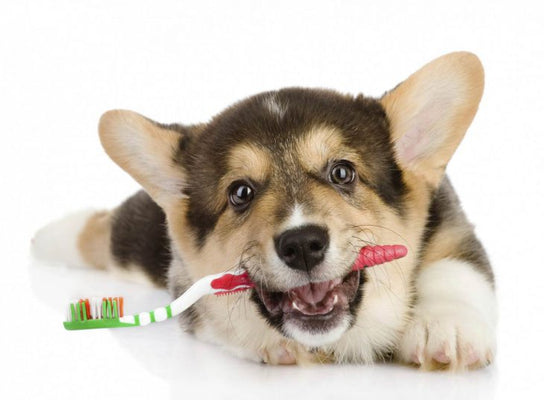Not many people know the importance about dog dental care. This guide will help you understand how to keep your dog’s teeth clean and healthy and explain why your dog’s oral hygiene should not be neglected.
All responsible dog owners take great care of their dog’s health, including their nutrition, fitness and entertainment needs. An often overlooked area, however, is dog dental care. An alarmingly high number of dog owners are reported to never have looked inside their dog’s mouth, on the flawed presumption that dogs do not require dental care and that foul breath is normal. As a result, about 80% of adult dogs end up with serious diseases.
While dogs are not as prone to dental hygiene issues as humans are, lack of cleanliness is bound to cause the buildup of plaque. This in turn not only causes issues like yellowing of the teeth and bad breath, but can actually lead to serious infections like gingivitis, pyorrhea and tartar, and in some cases, life-threatening conditions including liver and kidney disease. The oral hygiene of your pet, therefore, is extremely essential and needs to be regularly taken care of.
Training Your Dog for Teeth Cleaning
It is essential to begin dog dental care while your pet is still young. Not only is this important to ensure that potential dental issues are prevented, but it is also an essential part of training. Ideally, your pet should be comfortable with you poking around in their mouth and should not resist to the cleaning routine.
Before you ever start trying to brush their teeth, build their trust by using your finger dipped in something tasteful. Let the dog lick your finger and touch their teeth while they do, while also gradually handling their jaw and lips.
While an adult dog can, of course, be trained to stay calm and cooperative during teeth-cleaning, the process is inevitably easier when started earlier in their life.
Another great tip is to clean at the appropriate time, which is definitely not when your pup is jumpy and eager to play. Although individual behaviors differ, you will generally find the process easier when your dog has already had enough exercise for the day and is calmer.
Of course, it might not work out the first few times. Build up the process and let your pet warm up to it; if they are irritated at first, quit the process, but make sure to slightly prolong it every day, simultaneously praising them verbally, with treats or with a good belly rub. It may take a few days or a couple of weeks, but your dog will eventually start getting comfortable.
Dog Dental Care At Home – How to Clean Your Dog’s Teeth at Home
For the actual cleaning process, there are some essentials you must practice and some dog dental care products you must invest in.
Regular Brushing
Not unlike humans, a dog’s teeth need regular brushing. However, it is not as simple as that. It is very important to make sure that you buy the right equipment, since brushes and toothpastes made for humans just won’t work well. This is especially true for toothpastes because fluoride found in human toothpastes is poisonous for dogs! The same goes for alternatives like baking soda and salt, which can be harmful if swallowed.
Luckily, you can easily find appropriately formulated toothpastes. To make the process appealing to your dog, pastes and gels with mint flavor and meat flavor work amazingly.
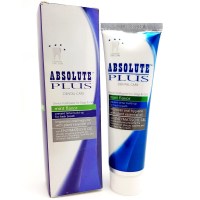
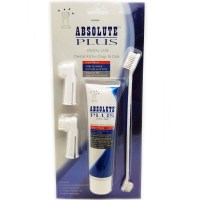
As for the dog dental care brushes, double-headed and finger toothbrushes works best.
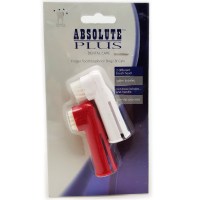
You might also want to invest in a reliable dental toothbrushing kit to avoid the hassle and the extra spending.
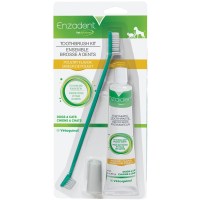
To brush your dogs teeth start out with these simple steps:
1) Lift your dog’s lip to expose their teeth and gums.
2) Placing your brush roughly at a 45 degree angle against the teeth and gums, brush with a gentle motion just like you would brush your own teeth.
3) Make sure you brush all the way, including the molars and canines, though you should be prepared for your dog to get agitated if you try to reach the inner sides of their teeth.
4) Once done, remember to reward your dog with a treat and lots of praise. Ideally, you should brush every day, or at least three to four times a week.
Dental Wipes and Pads
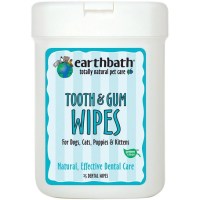
It is okay if your dog is not eager to get their teeth brushed every day. For the days when they don’t feel up to it, keep some dental pads or plain gauze pads handy, and wipe your pup’s teeth with them after they eat. A great product is Earthbath Tooth and Dental Wipes. It will barely take a few seconds but will go a long way in preventing bacteria buildup.
Use Chew Toys or Dental Treats for Cleaning
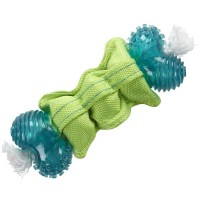
While your dog cannot brush their teeth, they definitely can and love to chew on things, so why not mix playtime with dog dental care? There are several synthetic and massaging chew toys and treat bones out there that are made specifically for dental hygiene.
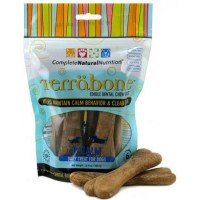
Not only are these safer than other toys and objects that can cause tooth breakage, they are also designed to strengthen the teeth and the gums. While these obviously aren’t alternatives to brushing teeth, the extra care certainly does go a long way.
You can also read more about The Best Edible Dog Chews in our earlier article.
Fresh Breath Gels

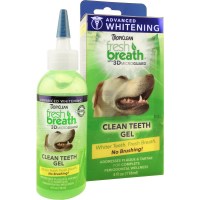
Nearly all dog owners are familiar with the bad breath dogs are prone to. While this can signify a serious dental problem, it is often merely a result of a raw or varied diet. To avoid this, invest in a trusted bad breath-focused product, like the Fuzzyard Peppermint and Eucalyptus Gel and the Tropiclean Fresh Breath Advanced Whitening Gel.
Water Additives
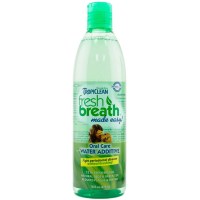
Water additives have gain popularity over the recent years in dog dental care products due to its ready availability, ease of use and relatively low cost. Just add some to your dog’s water bowl and it’ll help reduce the amount of plaque and tartar build-up in your dog’s mouth as well as giving him/her a cleaner, fresher breath.
Professional Dental Cleaning for Your Dog
Despite regular dog dental care at home, it is often recommended that you take your dog for professional cleaning at least once every six to twelve months. However, there are several oral hygiene issues that require immediate attention. These will almost always be presented by one of more of the following symptoms:
- Bad breath
- Swollen or bleeding gums
- Bumps or apparent cysts in the gums
- Unusual drooling
- Yellowing or rotting teeth
- Pain signifying by inactivity, pawing at the mouth or even depression
- Broken, loose or missing teeth
Anesthetic Versus Non-Anesthetic Dental Cleaning
At the vet’s, professional dog dental care is carried out through Scaling. The process entails scaling the teeth surfaces to remove plaque or tartar buildup, and then polishing the teeth.
For dogs with complex dental issues like gingivitis, surgery is often required. When it comes to anesthetics, most dog owners are reluctant and rather fearful, and often end up putting off dental care due to the presumed risks of anesthetics.
It is important to understand that is natural for you to be nervous about your putting your pet under for a lengthy medical procedure. For some, when surgery is absolutely needed, the only choices are to go on with the anesthetic procedure or to put it off altogether. The latter, as confirmed by veterinarian experts, can have a massive negative effect on the life span of the dog.
As for dental scaling and cleaning, the biggest dilemma is not the procedure itself but whether it occurs with or without anesthesia. While both types of procedures are approved and effective, they come with their benefits and repercussions and many factors come into play.
Overall health – The safe use of anesthetics on pets require a health evaluation, including the weight and the size of the dog. In some cases, your paranoia regarding anesthesia may be validated by pre-screening tests; for a dog that has weak organs, anemia or a below-ideal blood count, anesthesia is often risky, as any reliable practitioner will inform you. For healthy dogs, however, it is almost always harmless and is merely about putting your dog under for a couple of hours.
Complete and effective cleanliness – For dogs that have ideal dental care, extensive professional cleaning may not be required. However, cleaning on the inner sides of the teeth and beneath the gumline is often essential for many dogs and it is practically impossible to perform on an unanesthetized patient. While cleaning only on the front may result in whiter teeth, it will not cater to problems like bad breath and root damage. For dogs with the latter problems, anesthetic cleaning may be dire.
The discomfort and anxiety – The choice will majorly come down to you and to your knowledge of the temperament of your dog. Just like yourself, with anesthesia-free scaling, your dog will not enjoy being restrained in a dental chair with their mouth open and being poked in for a lengthy amount of time. It is inevitably more difficult for your beloved pet, since they have no understanding of what is being done to them.
For dogs that have anxiety issues, it is often impossible to complete the scaling process without them crying and being traumatized. Since you know your dog best, you will have to be the judge of whether you can comfort them and make them feel calm and safe during the process, or whether it will be too scary for them. It is argued that anesthetic cleaning will not only prevent the resistance and the distress, but also the pain resulting from the examination and the procedure.
While anesthesia can technically never be 100% risk-free, many veterinarians argue that this holds true for humans as well. As long as the process is being performed by a licensed and experienced professional, you should have nothing to worry about.
Conclusively, it is important to remember that oral hygiene is a huge part of your dog’s health and cannot be underestimated. Experts go as far as saying that a dog with perfect dental hygiene will live four to five years longer than a dog without any. To keep your beloved pet from dental diseases and the pain and discomfort they bring with them, never hesitate in spending time, effort and money on their oral hygiene needs; you will eventually have a pet that is healthy, energetic, happy, and makes for a perfect companion for several years to come!
